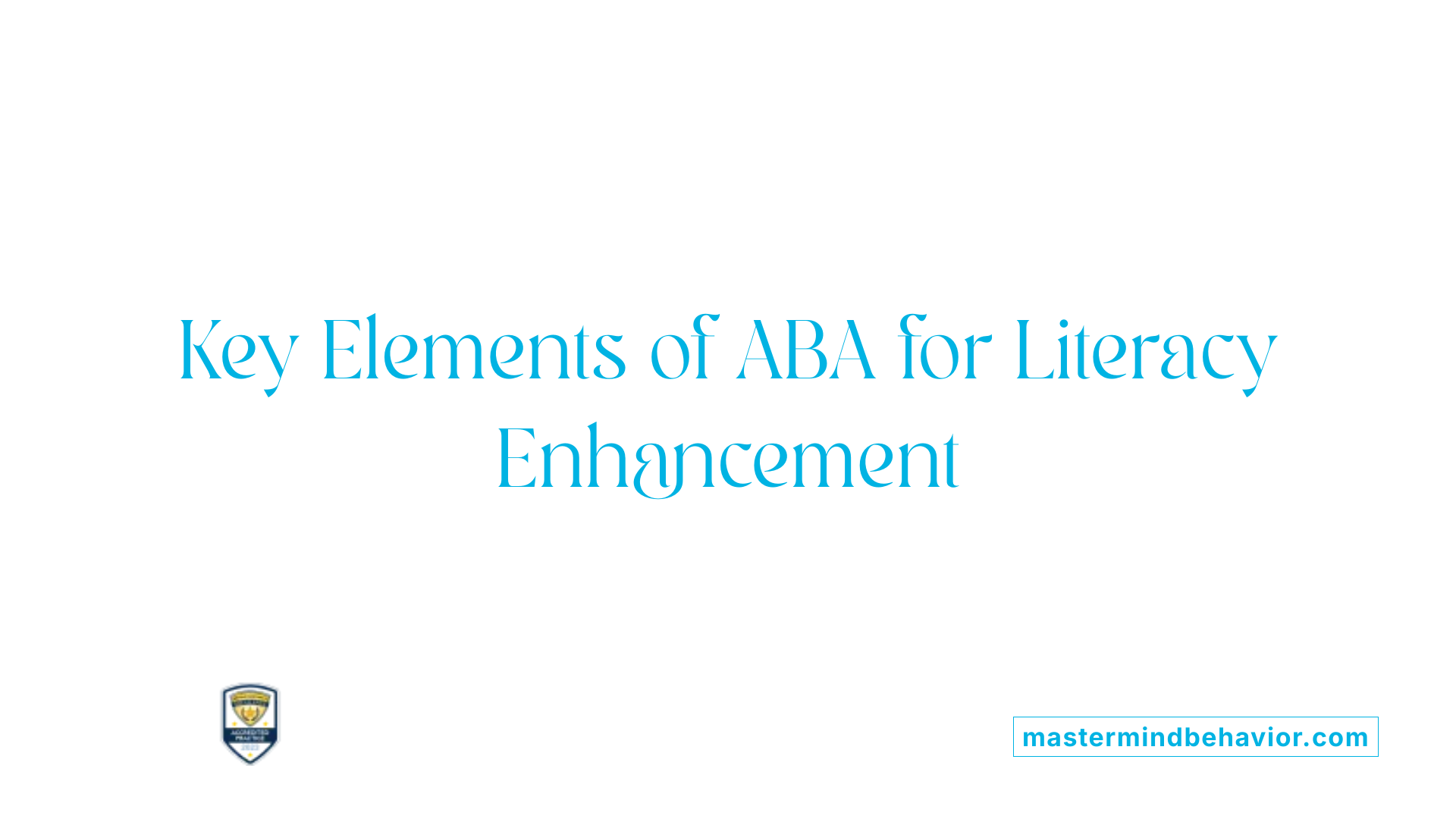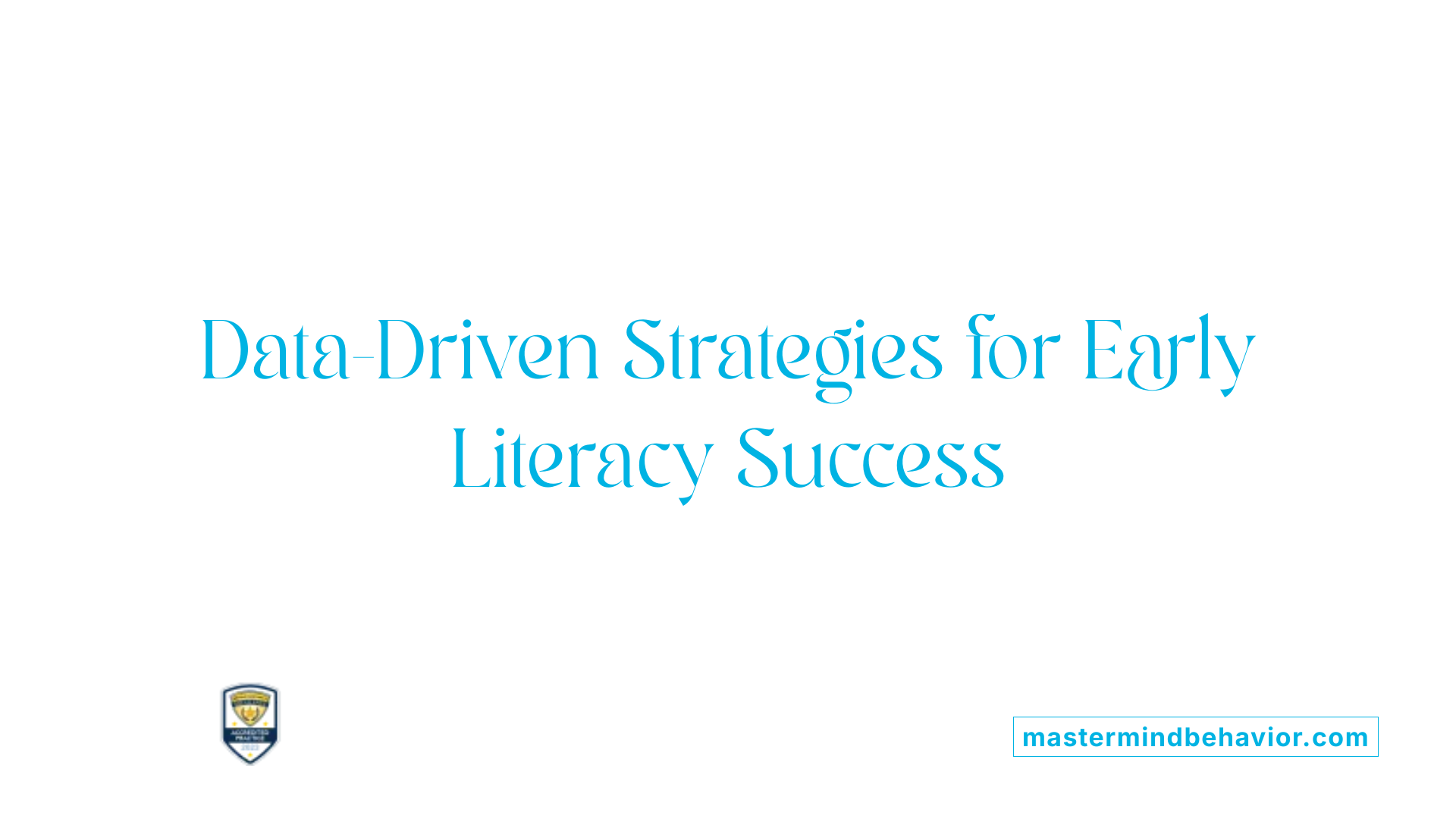Bridging Behavioral Therapy and Literacy Development
Applied Behavior Analysis (ABA) has long been recognized for its transformative impact on individuals with autism spectrum disorder (ASD). When leveraged to foster early literacy skills, ABA offers a structured yet flexible approach that adapts to each child's unique learning style and developmental needs. This article explores how ABA therapy supports early literacy acquisition, highlighting the science behind its methods, its implementation, and the promising outcomes it delivers.
Understanding ABA Therapy and Its Role in Autism Support
What is applied behavior analysis (ABA) therapy for autism?
Applied Behavior Analysis (ABA) therapy is a scientifically grounded method that focuses on understanding and improving behaviors in individuals with autism spectrum disorder (ASD). It examines how behavior is influenced by the environment and learning processes, using strategies such as positive reinforcement to encourage desirable behaviors and reduce problematic ones.
Definition and principles of ABA therapy
ABA therapy is built on principles of behavioral science and learning theory, particularly operant conditioning. Central strategies include analyzing behavior using the Antecedent-Behavior-Consequence (A-B-C) model, reinforcing positive actions, and customizing treatment plans based on thorough assessments by Board Certified Behavior Analysts (BCBAs). It is flexible and can be carried out in settings like homes, schools, or communities, adapting to individual needs.
Key goals of ABA in autism intervention
The primary objectives of ABA are to enhance communication, social skills, self-help, play, academics, and motor skills while minimizing behaviors that hinder learning or safety. Therapy programs aim to teach adaptive alternatives to challenging behaviors and empower parents and caregivers to support ongoing development.
Behavioral science foundations and learning theories applied in ABA
ABA employs methods such as Discrete Trial Training (DTT), naturalistic teaching, Pivotal Response Treatment (PRT), and Functional Communication Training (FCT). Early intensive intervention with ABA has demonstrated substantial improvements in developmental areas, supported by decades of research and endorsement by professional bodies. Data-driven evaluation helps monitor progress and adjust interventions, making ABA an evidence-based and effective approach for autism support.
Core Components of ABA Programs Tailored for Literacy

What are the key components of an ABA therapy program?
ABA therapy programs begin with individualized assessments conducted by a Board Certified Behavior Analyst (BCBA). These comprehensive evaluations identify a person's unique strengths and developmental needs, which lay the foundation for creating highly customized treatment plans.
Setting literacy-related goals within ABA
Within these individualized plans, specific goals related to literacy—such as letter recognition, reading comprehension, and writing—are established alongside broader targets like communication, social skills, and self-care. Goals are measurable and tailored to the individual's current abilities and interests, ensuring meaningful progress in literacy and related skills.
Techniques used like Discrete Trial Training (DTT) and naturalistic teaching
ABA employs various instructional strategies to promote learning. Discrete Trial Training (DTT), one of the earliest and most structured approaches, breaks down skills into small, manageable tasks reinforced through repeated practice and positive reinforcement. Complementing DTT, naturalistic teaching embeds literacy learning into everyday activities and play, leveraging the learner's motivation and natural environment to foster skill acquisition in more flexible, generalized contexts.
Use of A-B-C framework in behavior modification
The Antecedent-Behavior-Consequence (A-B-C) framework is central in modifying behaviors that may interfere with literacy development. By understanding what triggers a behavior (Antecedent), observing the behavior itself (Behavior), and examining its outcome (Consequence), therapists can design interventions that encourage helpful behaviors, like attention or task initiation, and reduce disruptive behaviors impeding literacy learning.
Additional components ensuring success
Ongoing data collection during sessions allows therapists to monitor progress meticulously, adjusting interventions based on what works best for each individual. Family and caregiver involvement is crucial, empowering them to reinforce literacy skills and behavioral strategies across home and community settings, which promotes skill generalization and maintenance.
Together, these components create a dynamic, evidence-based framework that effectively supports literacy development within ABA therapy programs.
The Science Behind ABA: Learning Theory and Behavior Change
What is the operant conditioning foundation of ABA?
Applied Behavior Analysis (ABA) is firmly grounded in operant conditioning, a learning theory that explains behavior through consequences. It posits that behaviors followed by positive outcomes are more likely to be repeated, while those followed by negative or neutral outcomes tend to diminish. This principle drives ABA's approach to behavior modification.
How does positive reinforcement play a role in ABA?
Positive reinforcement is a cornerstone of ABA therapy. It involves rewarding desirable behaviors immediately after they occur, thereby increasing the likelihood that these behaviors will continue. For example, a child may receive verbal praise or a favorite toy after completing a task. This reinforcement encourages learning and the development of functional skills.
How are antecedents and consequences analyzed in ABA?
ABA uses the A-B-C framework: Antecedent, Behavior, and Consequence. The antecedent is the event or environment that triggers a behavior. The behavior is the action performed by the individual. The consequence follows the behavior and influences its future occurrence. By understanding this sequence, therapists can identify what triggers and maintains behaviors, which informs targeted interventions.
Why is data-driven decision making essential in ABA therapy?
ABA therapy relies heavily on systematic data collection and analysis. During therapy sessions, behavior analysts gather detailed records of behaviors, responses to interventions, and progress toward goals. This data guides treatment adjustments, ensuring that strategies are effective and tailored to the individual's needs. Continuous measurement makes ABA a dynamic, evidence-based approach to behavior change.
How ABA Therapy Enhances Early Literacy Skills in Children with Autism
Teaching communication and language via ABA
ABA therapy plays a vital role in teaching communication and language skills to children with autism, forming the foundation for early literacy. Through individualized programs and consistent positive reinforcement, children learn to understand and express language. These language skills are essential for later reading and writing abilities.
Building foundational pre-literacy skills
Before formal reading and writing can begin, ABA helps develop pre-literacy skills such as attention to printed materials, recognizing letters, sounds, and understanding the concept of books. These skills are taught systematically and reinforced in natural settings to maximize learning.
Use of task analysis to break down reading and writing skills
ABA uses task analysis to divide complex reading and writing tasks into smaller, manageable steps. For example, learning to write a letter is broken down into stages like holding a pencil, tracing shapes, and forming letters correctly. This step-by-step approach helps children gradually master each component.
Generalization of literacy skills across environments
ABA emphasizes teaching skills in varied settings—home, school, and community—to ensure children can apply literacy skills in different contexts. This generalization helps children transfer reading and writing abilities to everyday activities, enhancing their independence and confidence.
How does ABA therapy benefit individuals with autism?
ABA benefits children with autism by scientifically promoting language, social interaction, and adaptive behaviors essential for literacy and beyond. It increases helpful skills while reducing behaviors that interfere with learning, using data-driven, evidence-based approaches for lasting developmental progress.
ABA Techniques Supporting Early Literacy: From DTT to Naturalistic Approaches
Discrete Trial Training (DTT) for structured learning
Discrete Trial Training (DTT) is one of the earliest ABA methods, characterized by highly structured and repetitive tasks designed to teach specific skills. In the context of early literacy, DTT helps children focus on foundational skills like letter recognition, phonemic awareness, and matching sounds to letters. This method relies on clear instructions and immediate positive reinforcement for correct responses, ensuring that learning is systematic and measurable.
Pivotal Response Treatment (PRT) and motivation
Pivotal Response Treatment (PRT) takes a more naturalistic approach by targeting pivotal behaviors such as motivation and response to multiple cues. When applied to early literacy, PRT encourages children to engage with reading and communication activities that interest them, which enhances their motivation. This approach helps generalize literacy skills to different settings by making learning meaningful and child-directed.
Incidental teaching in natural contexts
Incidental teaching involves embedding literacy learning within everyday activities and play. Instead of isolated drills, this technique capitalizes on natural opportunities for teaching reading and language skills during routine moments, such as storytime or grocery shopping. This strategy helps children connect literacy with real-life experiences, promoting better retention and spontaneous use of skills.
Functional Communication Training (FCT)
Functional Communication Training (FCT) focuses on teaching children effective ways to communicate their needs and thoughts, which supports literacy development indirectly. By reducing problematic behaviors linked to communication frustrations, FCT creates a more positive learning environment where children can focus on acquiring reading and writing skills.
Integration of play-based activities
Modern ABA techniques often integrate play-based activities, such as those used in the Early Start Denver Model (ESDM). These activities combine ABA principles with natural play to enhance engagement and skill acquisition. Play provides opportunities to practice literacy skills like storytelling, vocabulary building, and comprehension in an interactive and enjoyable way.
| Technique | Focus Area | Description |
|---|---|---|
| Discrete Trial Training (DTT) | Structured skill-building | Teaches foundational literacy through repetitive, reinforced tasks |
| Pivotal Response Treatment (PRT) | Motivation and generalization | Uses child interests to increase motivation and apply skills in natural contexts |
| Incidental Teaching | Natural learning opportunities | Embeds literacy teaching into everyday activities and play |
| Functional Communication Training (FCT) | Communication support | Teaches communication to reduce behavioral issues, facilitating better learning |
| Play-based Activities (ESDM) | Engagement and holistic learning | Combines ABA and play for interactive literacy development |
Role of the Therapist and Caregivers in ABA Literacy Interventions

Who provides ABA therapy and how is it administered?
ABA therapy is delivered primarily by qualified professionals such as board-certified behavior analysts (BCBAs), therapists, and trained technicians. These experts conduct thorough assessments to develop individualized treatment plans tailored to the specific developmental and literacy goals of each child.
Therapy sessions take place across various environments including the home, school, and community settings. This flexibility helps ensure that learning is generalized and applicable across different contexts in everyday life.
Therapist and technician involvement
Therapists and technicians are responsible for implementing ABA interventions using a variety of evidence-based methods such as Discrete Trial Training (DTT), naturalistic teaching, and positive reinforcement strategies. They carefully collect data during sessions to monitor progress and make necessary adjustments to improve literacy and related skills.
Parent and caregiver training and empowerment
A crucial element of successful ABA interventions is the involvement of parents and caregivers. Through specialized training, families learn to apply ABA principles and strategies at home and in daily routines. This empowerment supports consistency and reinforces literacy skills beyond structured therapy times.
Administering therapy in home, school, and community settings
Administering ABA therapy across multiple settings promotes skill generalization and addresses challenges in real-life situations. Whether at home, in the classroom, or during community activities, therapists collaborate with caregivers and educators to create supportive environments conducive to literacy development and social communication.
These combined roles of therapists, technicians, and caregivers form the foundation of effective ABA literacy interventions, ensuring that therapeutic gains translate into meaningful, everyday improvements for children.
Evidence Supporting ABA's Effectiveness in Autism and Literacy Outcomes
Is ABA therapy evidence-based and what research supports its effectiveness?
ABA therapy is recognized as an evidence-based approach, backed by more than four decades of research demonstrating its benefits for individuals with autism spectrum disorder (ASD). Systematic reviews and meta-analyses consistently report improvements in communication, social skills, cognitive functioning, and adaptive behaviors following ABA interventions. These positive outcomes are especially notable in children under the age of 10, where early intensive therapy leads to more pronounced gains.
Improvements in communication, social skills, and academics
Research shows that ABA can enhance key developmental areas such as language acquisition, social interaction, and academic skills. Children undergoing ABA often show increased communication abilities and reduced challenging behaviors, which can interfere with learning. These improvements help pave the way for better integration in educational and social settings.
Impact of early intensive ABA interventions
Early intervention programs delivering 25 to 40 hours per week of ABA over one to three years have proven particularly effective. Landmark clinical projects, like the UCLA Young Autism Project, revealed that nearly half of the children treated intensively with ABA achieved normal intellectual functioning. Such results highlight the importance of starting treatment early and maintaining sufficient therapy intensity for optimal progress.
Use of standardized assessment tools like Vineland Adaptive Behavior Scales
ABA outcomes are frequently measured using standardized instruments such as the Vineland Adaptive Behavior Scales. These tools assess social, communication, and daily living skills, allowing therapists to monitor progress objectively and tailor interventions accordingly. Data-driven adjustments help maximize the benefits of therapy and track long-term developmental improvements.
While some studies have limitations, including less rigorous designs and a lack of long-term quality-of-life assessments, the broad consensus among researchers and clinical authorities confirms ABA as a mainstay, evidence-supported treatment for autism. It remains an essential option to foster literacy and communication skills in children with ASD.
Addressing Criticisms and Ethical Considerations of ABA in Literacy Development

Are there any criticisms or controversies associated with ABA therapy?
Historically, ABA therapy has faced criticisms due to its use of intense, rigid methods sometimes involving aversive techniques, which reportedly caused emotional distress or trauma in some children. This has raised ethical concerns about the impact on emotional well-being and the risk of fostering PTSD in vulnerable individuals.
Critics also highlight that ABA's focus on increasing compliance and reducing certain behaviors could unintentionally suppress autistic traits and individuality. Such an approach may mask rather than embrace the child's authentic self, which has sparked debate about its compatibility with neurodiversity — the idea of valuing neurological differences rather than trying to “fix” them.
How have modern ethical practices evolved in ABA?
In recent years, ABA has evolved substantially, adopting more ethical and positive methods. Modern ABA emphasizes positive reinforcement strategies that reward desirable behaviors without punishment, focusing on play-based and naturalistic settings like everyday interactions. Therapy programs are individualized by qualified behavior analysts to respect each child's unique strengths and needs.
This shift prioritizes the child’s dignity, emotional well-being, and meaningful quality of life improvements. Parental and caregiver involvement is encouraged to empower natural support beyond therapy sessions. Contemporary ABA seeks to support autistic individuals' independence rather than enforce mere compliance.
Balancing skill acquisition with neurodiversity acceptance
Ethical ABA practices aim to balance targeted skill development — such as communication, social interaction, and literacy — with a respectful acknowledgment of neurodiversity. By focusing on functional and adaptive skills that enhance autonomy and participation, ABA supports children's growth while honoring individual differences.
Therapists avoid attempts to eliminate behaviors simply because they are atypical unless they cause harm or impede learning, thus fostering an environment of acceptance and respect.
Ensuring dignity and emotional well-being in ABA therapy
Modern standards in ABA mandate continuous data collection and progress monitoring, ensuring treatment remains effective and aligned with the child's emotional health. Therapists aim for collaborative goal setting and employ options that reduce stress and anxiety.
Overall, current ABA approaches strive to provide supportive, individualized interventions that promote learning and communication without compromising dignity or emotional safety, addressing many past ethical concerns.
| Aspect | Historical Challenges | Modern Practices |
|---|---|---|
| Therapy style | Intense, rigid, sometimes aversive | Positive reinforcement, naturalistic, play-based |
| Focus | Compliance, behavior suppression | Skill development, autonomy, neurodiversity respect |
| Emotional impact | Emotional distress, trauma reported | Dignity, emotional well-being prioritized |
| Stakeholder involvement | Limited caregiver collaboration | Active parent/caregiver participation |
| Outcome measurement | Behavior-focused, sometimes narrow | Data-driven, holistic quality of life considerations |
Maximizing Early Literacy Success Through Data-Driven ABA Strategies

Importance of ongoing data collection and progress monitoring
In Applied Behavior Analysis (ABA), continuous data collection during therapy sessions is essential to track a child's progress in early literacy skills. This systematic recording allows behavior analysts to observe how interventions impact language, communication, and academic abilities over time.
Adjusting interventions based on data
Therapists use collected data to make informed decisions about modifying instructional approaches. If a child is not progressing with a particular strategy, adjustments are made to better target the desired literacy skills or to reduce behaviors that impede learning.
Using evidence to inform instructional strategies and goals
ABA relies on evidence-based practices, meaning instructional strategies for literacy are tailored based on scientific data. Treatment goals are individualized, focusing on communication, reading, and comprehension, ensuring each child receives a program suited to their learning profile.
Ensuring skill generalization and maintenance
Data-driven ABA approaches emphasize not just acquiring literacy skills but also generalizing them across settings like home and school. Consistent monitoring helps maintain these skills long-term by reinforcing learning in natural environments.
This cycle of data collection, intervention adjustment, and reinforcement within ABA creates a dynamic, personalized framework that optimizes early literacy development for children with autism.
Integrating ABA with Educational and Community Supports for Literacy
Collaborative efforts among educators, therapists, and families
Successful literacy development in children with autism often stems from the strong collaboration between educators, ABA therapists, and families. Each group contributes unique insights and expertise. Educators understand curriculum demands, therapists provide behavior-based strategies, and families offer valuable knowledge about the child's preferences and daily routines. This team approach creates a consistent environment that supports the child's learning both in and out of the classroom.
Adapting ABA techniques in classroom settings
ABA strategies, such as positive reinforcement and the A-B-C framework, are effectively adapted for use in educational environments. For example, teachers may use discrete trial training (DTT) in reading lessons or incorporate naturalistic teaching during group reading activities. This flexible use of ABA ensures that literacy instruction aligns with the child's learning style while promoting engagement and motivation.
Supporting literacy skill transfer beyond therapy sessions
To ensure skills generalize beyond therapy, ABA programs emphasize practicing reading and communication in various settings. Role-playing, peer interactions, and community outings serve as natural opportunities to apply literacy skills. Data collection helps monitor how well these skills transfer, allowing therapists and educators to adjust interventions to support real-world use.
Community involvement and lifelong learning
Community participation enriches literacy development by offering authentic literacy experiences, such as visiting libraries, participating in story times, or engaging in local events. ABA’s individualized and data-driven approach supports lifelong learning by tailoring experiences to evolving goals, promoting continued growth in reading and communication throughout the person's life.
Looking Ahead: Future Directions in ABA and Early Literacy Development

Emerging ABA Models and Naturalistic Approaches
Recent developments in Applied Behavior Analysis have introduced more naturalistic models that complement traditional structured methods like Discrete Trial Training (DTT). Models such as the Early Start Denver Model (ESDM) and Pivotal Response Treatment (PRT) emphasize learning through play and the child's interests, making therapy more engaging and contextually relevant. These approaches show promise in supporting early literacy by embedding learning in meaningful interactions.
Need for Rigorous Research on Quality of Life and Literacy Outcomes
Although ABA's efficacy in improving core behavioral and developmental targets is well established, studies focusing on quality of life (QoL) outcomes and literacy skills are limited. More rigorous, controlled research is necessary to evaluate how ABA interventions influence long-term literacy development and overall well-being in children with autism spectrum disorder (ASD). This gap highlights the importance of expanding assessment tools beyond traditional behavioral measurements.
Comparisons with Alternative or Complementary Interventions
Future research should also involve systematic comparisons between ABA and emerging interventions, including those that focus specifically on literacy. Understanding how ABA complements or contrasts with other therapeutic approaches will help tailor individualized treatment plans. It can also establish standards integrating behavioral therapies with educational techniques for literacy and communication skills.
Potential for Technology-Assisted ABA Literacy Programs
Advances in technology offer new possibilities for enhancing ABA therapy targeted at early literacy. Interactive software, apps, and virtual platforms can deliver personalized, data-driven learning experiences that reinforce literacy skills within ABA frameworks. Technology-assisted programs may increase accessibility, engagement, and monitoring precision, paving the way for innovative, scalable literacy interventions.
| Aspect | Description | Implication for Literacy Development |
|---|---|---|
| Naturalistic ABA Models | ESDM, PRT focus on play, child interests, natural contexts | Embedded literacy learning through meaningful activities |
| Research Gaps | Lack of rigorous QoL and literacy outcome studies | Need for broader assessment and evidence-based refinements |
| Intervention Comparisons | Comparing ABA with alternative therapies | Supports integrated, individualized literacy and behavioral plans |
| Technology Integration | Use of apps, software, virtual platforms | Enhances personalized instruction, engagement, and data collection |
ABA Therapy: A Foundation for Lifelong Literacy Growth
ABA therapy represents a scientifically grounded, flexible, and individualized approach to fostering early literacy skills in children with autism. Its emphasis on positive reinforcement, data-driven methodologies, and family involvement creates fertile ground for meaningful developmental progress. While challenges and debates persist, modern ABA practices prioritize ethical considerations and seek to nurture each child's unique strengths and potential. As research continues to evolve and integration with broader educational frameworks grows, ABA stands as a beacon of hope for unlocking the literacy capabilities of many children on the autism spectrum, bolstering their independence and quality of life.
References
- Applied Behavior Analysis (ABA)
- Applied Behavior Analysis in Children and Youth with Autism ...
- The Role of Applied Behavior Analysis (ABA) in Early ...
- What Is Applied Behavior Analysis (ABA)?
- The Controversy Around ABA
- Is ABA therapy harmful? The controversy explained
- Debunking 7 Common Myths About ABA Therapy - GSEP Blog









